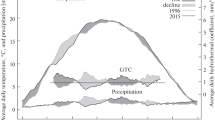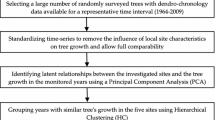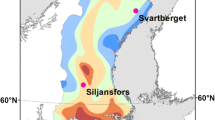Abstract
One of the ways to assess the impacts of climate change on plants is analysing their long-term phenological data. We studied phenological records of 18 common tree species and their 8 phenological phases, spanning 65 years (1946−2010) and covering the area of the Czech Republic. For each species and phenophase, we assessed the changes in its annual means (for detecting shifts in the timing of the event) and standard deviations (for detecting changes in duration of the phenophases). The prevailing pattern across tree species was that since around the year 1976, there has been a consistent advancement of the onset of spring phenophases (leaf unfolding and flowering) and subsequent acceleration of fruit ripening, and a delay of autumn phenophases (leaf colouring and leaf falling). The most considerable shifts in the timing of spring phenophases were displayed by early-successional short-lived tree species. The most pronounced temporal shifts were found for the beginning of seed ripening in conifers with an advancement in this phenophase of up to 2.2 days year−1 in Scots Pine (Pinus sylvestris). With regards to the change in duration of the phenophases, no consistent patterns were revealed. The growing season has extended on average by 23.8 days during the last 35 years. The most considerable prolongation was found in Pedunculate Oak (Quercus robur): 31.6 days (1976−2010). Extended growing season lengths do have the potential to increase growth and seed productivity, but unequal shifts among species might alter competitive relationships within ecosystems.



Similar content being viewed by others
References
Adamík P, Král M (2008) Climate and resource-driven long-term changes in dormice populations negatively affect hole-nesting songbirds. J Zool 275:209–215
Ahas R, Aasa A, Menzel A, Fedotova VG, Scheifinger H (2002) Changes in European spring phenology. Int J Climatol 22:1727–1738
Brázdil R, Chromá K, Dobrovolný P, Tolasz R (2008) Climatic fluctuations in the Czech Republic during the period 1961–2005. Int J Climatol 29:223–242
Brázdil R, Bělínová M, Rožnovský J (2011) Phenological observations made by the I. R. Bohemian Patriotic-Economic Society, 1828−1847. Theor Appl Climatol 105:71–81
Chmielewski F-M, Rötzer T (2001) Response of tree phenology to climate change across Europe. Agr Forest Meteorol 108:101–112
Chmielewski F-M, Rötzer T (2002) Annual and spatial variability of the beginning of growing season in Europe in relation to air temperature changes. Climate Res 19:257–264
Defila C, Clot B (2001) Phytophenological trends in Switzerland. Int J Biometeorol 45:203–207
Easterling DR (2002) Recent changes in frost days and the frost-free season in the United States. Bull Am Meteorol Soc 83:1327–1332
Estrella N, Menzel A (2006) Responses of leaf colouring in four deciduous tree species to climate and weather in Germany. Climate Res 32:253–267
Estrella N, Sparks TH, Menzel A (2009) Effects of temperature, phase type and timing, location, and human density on plant phenological responses in Europe. Climate Res 39:235–248
Fitter AH, Fitter RSR (2002) Rapid changes in flowering time in British plants. Science 296:1689–1691
Garzía-Mozo H, Mestre A, Galán C (2010) Phenological trends in southern Spain: a response to climate change. Agr Forest Meteorol 150:575–580
Gordo O, Sanz JJ (2009) Long-term temporal changes of plant phenology in the Western Mediterranean. Glob Change Biol 15:1930–1948
Harrington R, Woiwood I, Sparks T (1999) Climate change and trophic interactions. Tree 14:146–150
Heide OM, Prestrud AK (2005) Low temperature, but not photoperiod, controls growth cessation and dormancy induction and release in apple and pear. Tree Physiol 25:109–114
Hlavinka P, Trnka M, Semerádová D, Dubrovský M, Žalud Z, Možný M (2009) Effect of drought on yield variability of key crops in Czech Republic. Agr Forest Meteorol 149:431–442
Kalvāne G, Romanovskaja D, Briede A, Bakšienė E (2009) Influence of climate change on phenological phases in Latvia and Lithuania. Climate Res 39:209–219
Körner C, Basler D (2010) Phenology under global warming. Science 327:1461–1462
Kunkel KE, Easterling DR, Hubbard K, Redmond K (2004) Temporal variations in frost-free season in the United States: 1895 − 2000. Geophys Res Lett 31:1–4
Larcher W (2006) Altitudial variation in flowering time of lilac (Syringa vulgaris L.) in the Alps in relation to temperature. Sitzungberichte und Anzeiger der mathematisch- naturwissenschaftlichen Klasse 212:3–18
Linkosalo T, Häkkinen R, Terhivuo J, Tuomenvirta H, Hari P (2009) The time series of flowering and leaf bud burst of boreal trees (1846−2005) support the direct temperature observations of climatic warming. Agr Forest Meteorol 149:453–461
Menzel A, Fabian P (1999) Growing season extended in Europe. Nature 397:659–659
Menzel A, Estrella N, Fabian P (2001) Spatial and temporal variability of the phenological seasons in Germany from 1951 to 1996. Glob Change Biol 7:657–666
Menzel A, Sparks TH, Estrella N, Koch E, Aasa A, Ahas R, Alm-Kübler K, Bissolli P, Braslavská O, Briede A, Chmielewski FM, Crepinsek Z, Curnel Y, Dahl Å, Defila C, Donnelly A, Filella Y, Jatczak K, Måge F, Mestre A, Nordli Ø, Peñuelas J, Pirinen P, Remišová V, Scheifinger H, Striz M, Susnik A, van Vliet AJH, Wielgolaski F-E, Zach S, Zust A (2006) European phenological response to climate change matches the warming pattern. Glob Change Biol 12:1969–1976
Mozny M, Tolasz R, Nekovar J, Sparks T, Trnka M, Zalud Z (2009) The impact of climate change on the yield and quality of Saaz hops in the Czech Republic. Agr Forest Meteorol 149:913–919
Myking T, Heide OM (1995) Dormancy release and chilling requirement of buds of latitudinal ecotypes of Betula pendula and B. pubescens. Tree Physiol 15:697–704
Nekovář J, Hájková L (2010) Fenologická pozorování v Česku−Historie a současnost. Meteorologické zprávy 63:13–20
Nekovář J, Dalezios N, Koch E, Kubin E, Nejedlik P, Niedzwiedz T, Sparks T, Wielgolaski F-E (2008) The history and current status of plant phenology in Europe. COST Action 725, Brussels
Partanen J, Koski V, Hänninen H (1998) Effects of photoperiod and temperature on the timing of bud burst in Norway spruce (Picea abies). Tree Physiol 18:811–816
Partanen J, Leinonen I, Repo T (2001) Effect of accumulated duration of the light period on bud burst in Norway spruce (Picea abies) of varying ages. Silva Fenn 35:111–117
R Development Core Team (2012) R: A language and environment for statistical computing. R Foundation for Statistical Computing, Vienna, Austria. ISBN 3-900051-07-0, URL http://www.R-project.org.
Rathcke B, Lacey EP (1985) Phenological patterns of terrestrial plants. Annu Rev Ecol Syst 16:179–214
Reyssat E, Mahadevan L (2009) Hygromorphs: from pine cones to biometric bilayers. J R Soc Interface 6:951–957
Root TL, Price JT, Hall KR, Schneider SH, Rosenzweig C, Pounds JA (2003) Fingerprints of global warming on wild animals and plants. Nature 421:57–60
Rötzer T, Chmielewski F-M (2001) Phenological maps of Europe. Climate Res 18:249–257
Schaber J, Badeck F-W (2005) Plant phenology in Germany over the 20th century. Reg Environ Change 5:37–46
Schleip C, Sparks TH, Estrella N, Menzel A (2009) Spatial variation in onset dates and trends in phenology across Europe. Climate Res 39:249–260
Schwartz MD (2003) Phenology: an integrative environmental science. Kluwer, Dordrecht
Schwartz MD, Ahas R, Aasa A (2006) Onset of spring starting earlier across the Northern Hemisphere. Glob Change Biol 12:343–351
Sparks TH, Menzel A (2002) Observed changes in seasons: an overview. Int J Climatol 22:1715–1725
Sparks TH, Jaroszewicz B, Krawczyk M, Tryjanowski P (2009) Advancing phenology in Europe’s last lowland primeval forest: non-linear temperature response. Climate Res 39:221–226
Stříž M, Nekovář J (2010) Prostorová a časová analýza prvních květů a listů smrku obecného (1961−1990, 1991−2009). Meteorologické zprávy 63:101–107
Tooke F, Battey NH (2010) Temperate flowering phenology. J Exp Bot 61:2853–2862
Trnka M, Brázdil R, Dubrovský M, Semerádová D, Štěpánek P, Dobrovolný M, Možný M, Eitzinger J, Málek J, Formayer H, Balek J, Žalud Z (2011a) A 200-year climate record in Central Europe: implications for agriculture. Agron Sustain Dev 31:631–641
Trnka M, Eitzinger J, Semerádová D, Hlavinka P, Balek J, Dubrovský M, Kubu G, Štěpánek P, Thaler S, Možný M, Žalud Z (2011b) Expected changes in agroclimatic conditions in Central Europe. Clim Chang 108:261–289
Trnka M, Olesen JE, Kersebaum KC, Skjelvåg AO, Eitzinger J, Seguin B, Peltonen-Sainio P, Rötter R, Iglesias A, Orlandini S, Dubrovský M, Hlavinka P, Balek J, Eckersten H, Cloppet E, Calanca P, Gobin A, Vučetić V, Nejedlik P, Kumar S, Lalic B, Mestre A, Rossi F, Kozyra J, Alexandrov V, Semerádová D, Žalud Z (2011c) Agroclimatic conditions in Europe under climatic change. Glob Change Biol 17:2298–2318
Visser ME, Both C (2005) Shifts in phenology due to global climate change: the need for a yardstick. P Roy Soc Lond B Bio 272:2561–2569
Visser ME, Holleman LJM (2001) Warmer springs disrupt the synchrony of oak and winter moth phenology. P Roy Soc Lond B Bio 268:289–294
Walther G-R, Post E, Convey P, Menzel A, Parmesan C, Beebee TJC, Fromentin J-M, Hoegh-Guldberg O, Bairlein F (2002) Ecological responses to recent climate change. Nature 416:389–395
Zhang X, Friedl MA, Schaaf CB, Strahler AH, Schneider A (2004) The footprint of urban climates on vegetation phenology. Geophys Res Lett 31:1–4
Ziello C, Estrella N, Kostova M, Koch E, Menzel A (2009) Influence of altitude on phenology of selected plant species in the Alpine region (1971−2000). Climate Res 39:227–234
Author information
Authors and Affiliations
Corresponding author
Electronic supplementary material
Below is the link to the electronic supplementary material.
ESM 1
(PDF 1701 kb)
Rights and permissions
About this article
Cite this article
Kolářová, E., Nekovář, J. & Adamík, P. Long-term temporal changes in central European tree phenology (1946−2010) confirm the recent extension of growing seasons. Int J Biometeorol 58, 1739–1748 (2014). https://doi.org/10.1007/s00484-013-0779-z
Received:
Revised:
Accepted:
Published:
Issue Date:
DOI: https://doi.org/10.1007/s00484-013-0779-z




